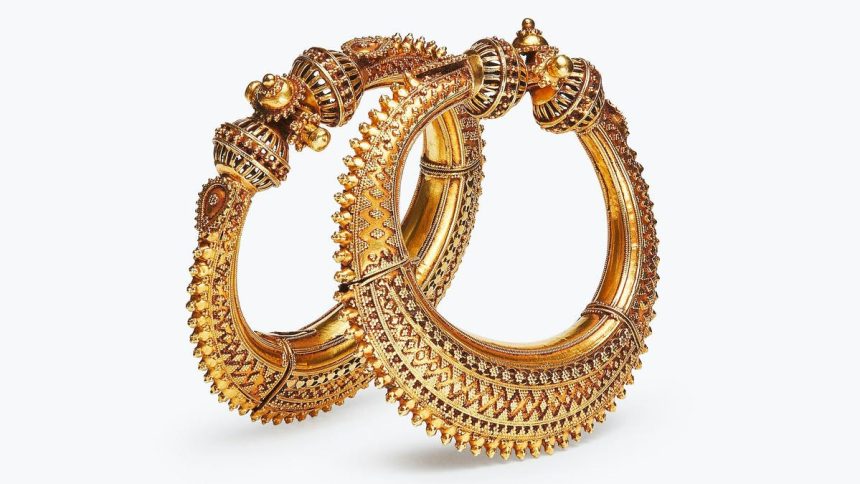The Van Gelder sisters have built a successful brand around the dialog between traditional Indian adornment and present-day design, creating contemporary jewels that sit alongside an extensive family collection of heritage pieces. Since 1980, the family business has brought antique Indian jewelry to the West, via the charming Dutch city of ‘s Hertogenbosch. In 2019, they added contemporary collections, and have since grown a dedicated community of global collectors. Now, they are celebrating five years of Van Gelder Designs, with a move into gender-free jewelry.
The Northernwestern European sun pours through the windows of the Van Gelder townhouse, igniting 17th century gemstones, warming 22 carat Indian gold and setting vibrant antique enamel aflame. Pieces from the family’s extensive collection of Indian heritage jewelry sit alongside modern jewels, amongst exquisite 19th century prints from the catalog of the Jaipur Exhibition, in a hybrid gallery space, showroom and studio in the historic heart of their home city. The contemporary line is designed by Fleur Damman-van Gelder, while her sister Noelle Viguurs-van Gelder looks after commercial development. Really however, these are pieces born of a shared heritage and aesthetic, shaped by an upbringing that took the sisters far from the Dutch countryside, exposing them to the rich Indian culture with which their mother, Bernadette, had already fallen in love.
“It was only when we grew older that we really appreciated how special this was,” Noelle tells me, of their extensive travels to the country as their mother compiled her collection. Bernadette still lives a few streets away, in a beautifully restored Dutch townhouse, packed to the rafters with the art and artefacts collected over a lifetime’s travel. She has poured her expertise into two books — The Golden Smile of India and Beautiful People — which explore the significance of jewelry in Indian society through the ages, and records a cultural heritage which would eventually inspire her daughters to create contemporary jewelry in response to the collection.
With a focus on line and color, the modern jewelry is minimalist and confident, honoring the heritage collection with a completely new aesthetic, in sculptural earrings, liquid chain and graceful openwork. In 2007, Fleur had just designed a first collection of contemporary rings, when she suffered a traumatic head injury while horse riding, which required ten years of recovery. “It was five years before my creativity came back and I could gradually start designing again,” she says, “but that journey has been a gift, a catalyst for creativity that has fuelled our contemporary collections”.
After her years spent in recovery, the quiet and isolation of Covid lockdown was familiar territory for Fleur, that allowed her to concentration on exploration and design. She now has a visceral reaction to visuals and has developed an understanding of the power of color to uplift and heal. The Baoli collection, designed during the pandemic, features geometric and circular motifs inspired by the step wells in Indian temples, in a bright enamel palette. “We were drawn to meditative activities during the pandemic,” she tells me, “and walking down the steps to these wells in India has the same, almost spiritual effect. The clear stone at the center represents water, and also clarity; finding yourself.”
Produced in workshops in Jaipur, Van Gelder Designs launched in 2019, and now represents half of the company’s revenue, with steady growth year-on-year. Sales are often private, and in addition to the townhouse flagship, they have stockists elsewhere in the Netherlands, Switzerland and the US, as well as a regular presence at NouvelleBox market showroom at Paris Fashion Week. It’s a strategy of slow and steady growth that befits this discrete family company, led by women from a line of female entrepreneurs.
Bernadette set up antique Indian jewelry business in 1980 and was joined by her daughters in 2000. Each new piece in the collection, which includes jewels from the late 17th to mid-20th centuries, is meticulously researched before being exhibited for sale. “We work with the Dutch Gemmological Laboratory in Leiden to confirm stones and metals,” says Noelle, “independent provenance and materials verification allows us to confirm authenticity, after which we work with a local atelier on any restoration needed.”
Van Gelder Jewellery was one of the first exhibitors at the TEFAF art fair in Maastricht, where the company showed Indian heritage jewels for over 30 years, like the braid decoration from the 1900s, handcrafted from 22kt gold, with a shower of natural seed pearls. “Enamel was initially used to protect the gold,” says Noelle, “we know that this is from Rajasthan because of the white, red, blue and green used.” Enamel often appears on the underside of pendants and bracelets in constant contact with the skin, like a 19th century man’s necklace, whose plates of turquoise-studded gold, linked with ropes of pearls, are turned over to reveal enamel work every bit as vibrant as the day it was painted.
The Eastern tradition of body adornment for men – as well as women, children and even animals – has inspired Van Gelder’s upcoming gender neutral collection, set to launch in September. “Our vision of gender-free jewelry pays homage to our company’s Indian heritage foundation, and also aligns perfectly with Van Gelder’s core values of inclusivity and acceptance,” says Fleur. “Our new collection embraces this approach,” adds Noelle, “offering exquisite pieces that resonate with the essence of individuality, born of a creative journey to craft jewelry that transcends conventional gender boundaries.”
Later in the evening, the sisters open the townhouse up to the public, for a talk by Noelle on antique Indian jewelry at the Jaipur Exhibition, in 1883, several pieces from which are now in the Van Gelder collection. The atmosphere is warm and welcoming as a well-dressed set of international collectors share their enthusiasm for the jewels. To the delight of Noelle and Fleur, many of them are wearing previous Van Gelder purchases, pairing 300-year-old Indian necklaces with modern jewels, in a blend of past and present united by color and texture, that encapsulates the sisters’ approach.
“They have such deep knowledge,” one guest tells me, “their passion is infectious, it’s hard not to come away with a new piece.” And new or old, Eastern or Western, every piece in the collection speaks of passion and perfectionism, talent and tenacity, of generations of enterprising women following their hearts and intuition to build a unique and engaging business.
Read the full article here










